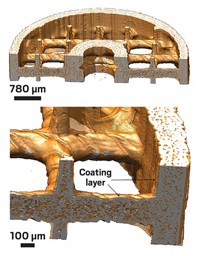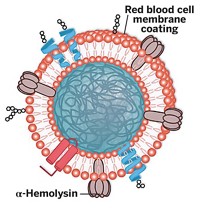Advertisement
Grab your lab coat. Let's get started
Welcome!
Welcome!
Create an account below to get 6 C&EN articles per month, receive newsletters and more - all free.
It seems this is your first time logging in online. Please enter the following information to continue.
As an ACS member you automatically get access to this site. All we need is few more details to create your reading experience.
Not you? Sign in with a different account.
Not you? Sign in with a different account.
ERROR 1
ERROR 1
ERROR 2
ERROR 2
ERROR 2
ERROR 2
ERROR 2
Password and Confirm password must match.
If you have an ACS member number, please enter it here so we can link this account to your membership. (optional)
ERROR 2
ACS values your privacy. By submitting your information, you are gaining access to C&EN and subscribing to our weekly newsletter. We use the information you provide to make your reading experience better, and we will never sell your data to third party members.
Biological Chemistry
Nanosponges Soak Up Toxins
Tiny membrane-coated particles keep poisonous proteins away from healthy cells, save mice injected with lethal doses
by Lauren K. Wolf
April 22, 2013
| A version of this story appeared in
Volume 91, Issue 16
To treat patients infected with protein toxins, doctors must know the origin of the poisons—whether they come from bacteria, snake venom, or elsewhere. That’s because small-molecule inhibitors or antibody therapies each deactivate toxins by binding to protein-specific structural features. A research team at the University of California, San Diego, however, has designed a new detoxification therapy that works against a whole class of toxins (Nat. Nanotechnol., DOI: 10.1038/nnano.2013.54). These pore-forming toxins kill cells, including red blood cells, by punching holes in their membranes. The UCSD researchers tricked these troublesome toxins into sticking to particles, dubbed nanosponges, that look like miniature cells from the outside. To make the decoy nanomaterials, the researchers, led by chemical engineer Liangfang Zhang, envelop poly(lactic-co-glycolic acid) nanoparticles with membranes extracted from the red blood cells of mice. When the team administered the 85-nm-diameter nanosponges to mice two minutes prior to a lethal dose of the bacterial toxin α-hemolysin, 89% of the rodents survived. Administered to mice two minutes after a lethal dose, the nanosponges saved 44% of the animals. Zhang says his team is now testing nanosponges coated with membranes from human red blood cells.





Join the conversation
Contact the reporter
Submit a Letter to the Editor for publication
Engage with us on Twitter